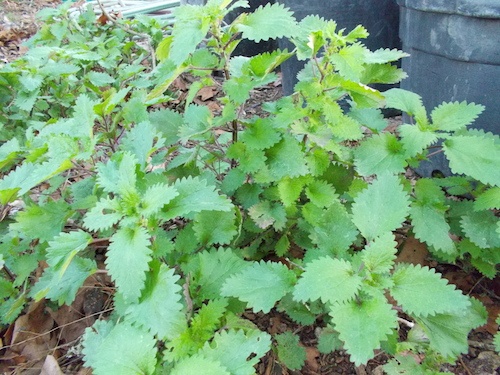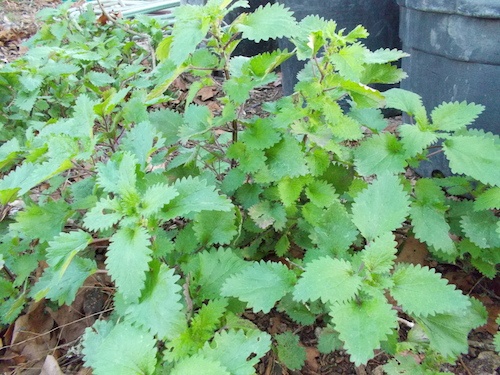The thought of eating nettles might alarm you, as this plant is especially painful with even the slightest brush up against it. But drying or cooking takes all the fight out of it and what is left is quite an amazing super food. It is one of the first to greens to emerge in the spring and in most places it is coming out right now (March).
I like to eat nettles in two ways. While it is young, I love eating it cooked fresh with garlic and butter (the basic recipe for making anything taste good!). I also dry enough to fill two half gallon mason jars and I keep that on hand to add to soups and stews throughout the year.
According to the USDA one cup of fresh cooked nettles has 555% of the RDI for vitamin K, 36% vitamin A, 43% calcium, 35% manganese, 13% magnesium, plus a smattering of other nutrients. Whew!
The plant is best harvested when it is less than knee high. Oh yes, wear thick gloves – did I really need to say that? Don’t take it all and you can get a second cutting. Of course, if you are taking from a wild stand, be mindful minimize your impact so the stand will be there for future years.
The Latin name Urtica dioica sounds much nicer than ‘stinging nettles’. There aren’t many plants that look like nettles, and the sting is a sure fire way to know you’ve got the right plant. While most plants that hurt, puncture, or pierce usually grow in harsh conditions (supporting the theory they are there to protect the land), nettles are an exception to that rule. Nettles are happiest on rich moist soil.
If you are into primitive skills, nettles stems have a lot of fiber and make fine cordage. Harvest in September or October while the plant stems are old and tough, but not dried or withered. If you haven’t ever made cordage from plants I highly recommend learning the basics – it will make you appreciate rope and para-cord so much more.
Marjory Wildcraft is an Expedition Leader and Bioneer Blogger with The [Grow] Network, which is an online community that recognizes the wisdom of “homegrown food on every table.” Marjory has been featured as an expert on sustainable living by National Geographic, she is a speaker at Mother Earth News fairs, and is a returning guest on Coast to Coast AM. She is an author of several books, but is best known for her “Grow Your Own Groceries” video series, which is used by more than 300,000 homesteaders, survivalists, universities, and missionary organizations around the world.









COMMENTS(0)
We used to eat the “peanut like seeds” that grow on nettles, after getting them out of their shells. But, it sounds like you are saying to harvest and eat the “greens” also. So, do you have to let them dry for a time, to loose their sting, or what. Or, just plop them into a pot and cook immediately ??? And, about the fiber, do they need to dry first, or, must you wear gloves while trying to separate the fibers??
Thank you.
Hi Malcolm,
I pick the nettles fresh, while young – below knee height. Yes, i just pop them fresh into the sauce pan with garlic and butter. The ‘sting’ disappears with the theat of cooking. Yummy.
For using nettles for fiber, you let the nettles grow to thier full height – 2′ or 3′ and wait until they dry on the stalk. then you collect them, strip them of leaves, and use the main stems for their fiber.
You now, I’ve never eaten the ‘peanut like seeds’. Haven’t ever bothered to look actually. I’ll do that this year. Always love another way to find something to eat.
Just wondering what temperature & how long to cook nettles. Do you sautee them like onions?
Oh a medium to low heat. They cook quite quickly. Yes sauteed like onions, only onions need a long time compared to nettles.
Loved this article. I live in the Deep South and we have nettles a plenty! How do you prepare your nettles for cooking?? Do you cut away the prickly tips, etc.?? Thanks!
Hi MemeB,
You know, that prickly stuff just goes away once they are cooked. Those ouchy stems just don’t have any sting to them once cooked.
Now gathering them is another story…. That takes gloves.
Er, well, there are techniques to gathering them without gloves, But really, you don’t want to do it. It involves folding the leaves in half to hold the stem.
I usually get stung anyway and think, hey, maybe this will prevent arthritis or something. It makes me feel a tiny bit better.
I’m sorry to post this here but I didn’t see another way to contact.
1. The Four Thieves tonic page and video do not work.
2. The home page doesn’t display correctly with FireFox.
Hi Darcy,
thanks for writing in. We just move servers, and now are changing the theme. And there have been a few hiccups. Of course! When its all done, the site is supposed to play well on any device.
Let us pray…
Really enjoyed the story. But, it didn’t exactly explain how to find them much other than in fertile soil.
Do you have more detail in the stinging needles?
Sincerely
James
James, I’ll post up more specifics.
Marjory,
We have a lot of nettles here in SC but they don’t look as lush as your picture. I wonder if they’re the same thing? They’re a real pain (literally and figurtively). The leaves have small spurs on the undersides. They have have a small pale blue/yellow bloom as I recall. This turns into a small tomato like fruit contained in a chinese lantern. They put deep runner roots out that are impossible to extract. What do you think?
Hi Stoney, You know what? I’ll take some photos and post them for you. Give me a day to get to it.
Does this plant grow in NEVADA? Can I Plant it? Are there seeds or is it a weed that comes on its own?
I heard of the pioneers making a tea from nettle, is this the same plant?
Hi Sharon,
Nettles are a weed that grows pretty much everywhere in the US. Hmm, where to get seeds? I just checked and Baker Creek Seeds at http://www.rareseeds.com/stinging-nettle/ has nettle seeds and info on growing them.
I did an interview with Jere Gettle – the owner of Baker Creek seeds. Check it out here:
Check it out where? I dont see a link for the interview.
I am so going to do this this year . Cant wait for the snow to go away and spring to arrive. So much to learn and so many ways to live off the land.
Thank you .. I will post after trying it this year , for sure.
the interview is located on this page;
When I was pregnant with my 4th baby, I developed this incredibly itchy rash all over my body towards the end of the pregnancy. My doctor wanted to prescribe a steroid cream, but that was simply not an option for me. I began researching some other natural remedies and came across one that said to drink lots of nettle tea. It was April and we had a nice big bunch of nettles in our yard so I decided to give it a try. Within just a couple days the rash was gone! The premise was that my liver just wasn’t able to keep up with the increased amount of blood in my body during pregnancy, and nettle tea is a great aid to the liver. As long as I kept drinking the tea daily the rash did not come back! I still drink it from time to time when I can find some nice fresh nettles. I think it tastes pretty good, especially over ice.